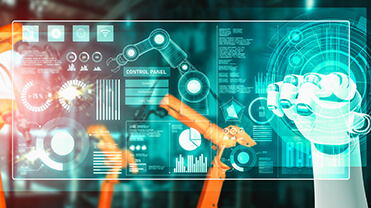navigating industrial IoT
with data analytics
Industry 4.0 embodies the fusion of physical and digital realms, driven by evolving technology and innovative solutions. Industrial automation stands out as a prime example of this convergence. Industries have consistently embraced technology throughout history, leading to pioneering innovations. One notable implementation is the application of data analytics in Industrial IoT (IIoT). This intersection benefits industries and extends to sectors like agriculture, healthcare, manufacturing, and more. This article explores how data analytics in IIoT is revolutionising industries worldwide.
Want to know more about IIoT? Read our article on Unleashing the power of IIoT: key considerations for industrial automation
setting the stage for data analytics with data preprocessing
In IIoT, data extraction precedes analytics, converting raw device data into structured formats for analysis. This phase refines, regulates, and ensures consistency across varied data formats due to IoT devices generating structured, semi-structured, and unstructured data. This foundation empowers data analysis, revealing insights that drive informed decisions and operational efficiency in industries.
convergence of data analytics and IIoT
This intricate web of connectivity sets the stage for data analytics, a multifaceted process that entails the examination, transformation, and modelling of raw datasets to get meaningful insights. It involves various techniques with varying levels of complexity, like processing diverse data types such as text, images, video recordings, and spreadsheets, each with distinct sizes and formats, leading to various types of data analytics:
- Descriptive analytics: Uncovers historical occurrences and patterns by analysing past data.
- Diagnostic analysis: Reveals the root causes of past events.
- Predictive analysis: Uses statistical techniques to anticipate future events.
- Prescriptive analysis: Suggests courses of action with associated outcomes.
application of data analytics in IIoT
predictive maintenance: Unexpected equipment breakdowns can cause substantial downtime in an industry. Data analytics predicts such failures by identifying patterns in datasets, thus averting downtimes. For instance, abnormal equipment vibrations can trigger proactive actions, through insights gained from data analytics.
Softdel built a cloud-based critical equipment condition assessment system for oil debris sensors, that enabled predictive equipment maintenance for actionable insights.
energy management: Energy is a fundamental lifeline for industries, but it is also cost-intensive. Using data analytics, industries can proactively monitor and optimise energy consumption, reducing carbon footprint and costs. For example, sensors in a workspace capture data on lighting, HVAC, and energy. Analytics uncovers energy usage patterns like lights being left on overnight or HVAC systems overworking during peak hours. Armed with these insights, lighting can be enabled with automatic schedules and HVAC systems can be configured to curtail unnecessary energy wastage.
Softdel developed a real-time monitoring platform that seamlessly integrated with ERP, equipment inventory, and operational applications, offering a comprehensive view of IoT and sensor-driven real-time emissions monitoring.
supply chain optimisation: Data analytics unlocks valuable insights across the entire supply chain, including demand forecasting, inventory management, logistics optimisation, and supplier performance evaluation. This comprehensive approach leads to impactful solutions, as exemplified by a pharmaceutical company’s initiative. They successfully harnessed operational performance data, allowing them to manufacture and globally distribute a critical vaccine, resulting in almost 10% cycle time reduction and ensuring uninterrupted supply of vital medications for patients. Demand forecast too plays a critical role in maintaining optimal inventory levels, reducing costs, and improving customer satisfaction, achieved through analysing historical data and market trends. Inventory management itself is a delicate balancing act – excessive stockpiles heighten storage costs and waste risks, while shortages disrupt supplies and sales. The remedy lies in analysing industry data, encompassing sales trends and seasonal variations, to prevent such challenges.
enhanced safety: Data analytics offers valuable avenues to identify potential hazards, facilitating proactive measures to prevent accidents and ensure a safe working environment. Although safety has traditionally relied heavily on human intervention, this application of new-age technologies can power industries with a more secure approach to achieving the same goal.
Softdel enhanced a company’s fire safety measures by developing a customisable Bluetooth Low Energy (BLE) interface for flame detectors, complemented with a cross-platform mobile application, thus enabling IoT connectivity for risk reduction and enhanced detector management.
future of data analytics in IIoT
With the rapid progression of AI and ML, data analytics in IIoT is poised to go a long way. Machine learning can excel in handling data and offer accurate insights. In unison with that, artificial intelligence automates decisions, managing real-time operations like demand surges or machinery issues. These technologies provide valuable insights due to extensive data from sensors, devices, assembly lines, supply chains, and interactions. Simultaneously, technologies like edge computing and advanced connectivity like 5G will facilitate faster and more reliable data transmission.
Learn about Softdel’s powerful edge gateway platform – EdificeEdge – which has already powered numerous comprehensive solutions across the industrial and building automation sectors.
IoT integration in industries aimed to improve existing processes with error-resistant operational mechanisms. Data analytics in Industrial IoT fortifies ongoing operations with stronger framework. As technology continues to evolve, the advancement of industries will unlock unforeseen levels of productivity, profitability, and innovation, ushering in a new era of digital transformation.








